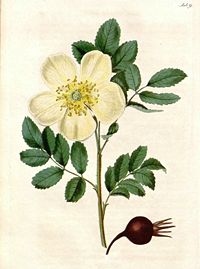Rose
 From Citizendium - Reading time: 2 min
From Citizendium - Reading time: 2 min
| Rosa | ||||||||||||||
|---|---|---|---|---|---|---|---|---|---|---|---|---|---|---|
 Rosa hemisphaerica
| ||||||||||||||
| Scientific classification | ||||||||||||||
| ||||||||||||||
| Type species | ||||||||||||||
| Rosa cinnamomea L. 1753 | ||||||||||||||
| Species | ||||||||||||||
|
About 140 species |
A rose is any of thousands of varieties of shrubs and flowers belonging to the genus Rosa. There is disagreement as to how many species of rose there are, and there are thousands of varieties and cultivars of those. Roses belong to a larger group called a family, named Rosaceae, and this includes brambles and briars.
Roses are significant to human beings in several ways: they are among the most popular of garden flowers, are frequently given as gifts, from expressions of love to expression of condolence, their fragrance is important in the perfume industry, and their dried seeds, called hips, are used medicinally and as herbal teas.
Cultivated roses are broadly divided into several groups:
- Hybrid tea rose
- English rose
- Modern rose
Wild roses, although not often seen in modern gardens due to their extreme prickliness and short flowering season, are nevertheless prized by those with enough room to enjoy them because of their often aromatic foliage and the soft sweetness of the scent of their flowers. They are generally only featured in the “wild garden”.
Roses have inspired some of the best-known lines in English-language literature, including:
- That which we call a rose, by any other name would smell as sweet.
William Shakespeare, Romeo and Juliet
- My Love is like a red, red rose
- A rose is a rose is a rose
 KSF
KSF